For Faster Service Call Directly
FREE ESTIMATE
Request Your Pest Control Estimate
In the decade between 2008 and 2018, the Centers for Disease Control and Prevention reported that cases of diseases caused by ticks in the United States had more than doubled.
This increase has not gone unnoticed. There is a heightened public awareness of the threat ticks pose, which has led many to go to the internet to find answers.
That is why we've put together this comprehensive guide. In it, you will find essential information for managing the threat of tick-borne diseases around and inside your Maryland, Virginia, or D.C. home.
Ticks are tiny arachnids that take warm-blooded mammals and birds as hosts, which allows them to survive in harsh, cold-weather conditions.
While cold temperatures can affect ticks, cold weather doesn't have as much of an impact on ticks as humidity does.
In states that get more humidity, ticks thrive. For this reason, tick populations are larger in states that are on the East and West coasts.
The coastlines are also where incidences of tick-borne diseases are the greatest, in particular, Lyme disease in humans and dogs, with a concentration of cases being in the northeastern U.S. from Virginia to Maine.
This is why ticks are a serious problem in our DMV service area. The weather in Washington D.C., Maryland, and Virginia is warm enough for ticks to be active most of the year and moist enough for them to thrive.
With more ticks to deal with, there is a greater risk of disease. That is why tick control is extremely important.
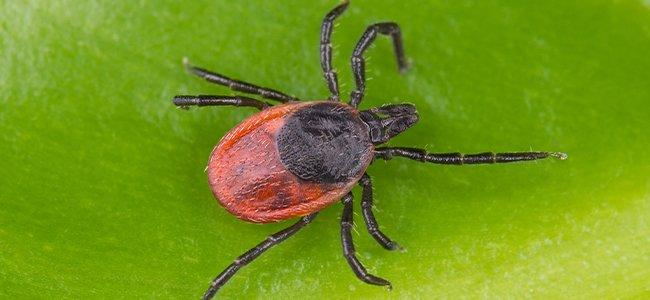
Request Your Pest Control Estimate
While there are many ways you can reduce ticks in your yard, the most effective way to reduce ticks and limit exposure is by investing in professional tick control service.
There are many reasons for this that we will get into below but the most important reason is that a licensed professional knows what products to use, how much to use, and where to apply control products for the best results. If you have questions about tick control, reach out to us for a free consultation. We'd be happy to give you an overview of how professional tick reduction works.
Whether you choose to invest in tick control service or not, it is important to understand what you can do to reduce ticks in your yard all year long. Here are some tips to help you in each season.
Winter Tick Control
Most people don't think of winter as a time of year to be worried about ticks, but ticks can be a threat even in the dead of winter when there are 6 feet of snow in your yard. This is because animals that carry ticks hide in man-made structures when temperatures drop. Our winter tick control tips focus on the detection of mice and rats, which can prompt you to get service to remove them.
Keep your exterior trash in sealed containers, put pet food or livestock food down only during mealtimes, clean up after cooking on the grill, and control other food sources to reduce wildlife traffic in your yard.
Trim bushes and remove clutter that animals may use as hiding places around your home.
Keep grass cut short and keep weeds plucked.
If you have a dog, consider creating a fenced-in play area, if you don't already have one. This will reduce wildlife traffic in this location and prevent your dog from exploring your landscaping where ticks are likely to be waiting for a host.
If you have bird feeders, move them away from your outside walls and out of your outside recreation areas.
If you have firewood on your property, keep it away from your home and elevate the stacks so that the wood doesn't rest on the ground.
If you are hiking or walking outside avoid heavily wooded areas where ticks tend to hide to look for their next host.
As we mentioned before, ticks love to climb and hide in tall grass, if you spend time in this type of areas, wearing clothes that cover your skin will prevent them from biting you.
Remove conditions that allow puddles to form, such as filling in holes or creating downgrades.
Fix leaky pipes, spigots, and hose and check for obstructed or damaged gutters and downspouts.
In the fall, ticks tend to look for warm places to get their next meal, removing any piles of leaves, sticks, or twigs in your yard will reduce the chances of ticks coming into your yard
Ticks also love to hide in tall grass and wild brush, if you keep these areas short and clean you'll create a barrier for ticks that are planning to visit your lawn.
Trim those branches that are close to or touching any side of your home.
If you have kids, make sure to set up a play structure that is in the center of your yard and far away from low-hanging trees.
White or light-colored clothing will help you spot any tick that you have picked up outside.
Once you come inside, make sure to do a tick-check, including your hairline, neck, armpits, groin, legs, knees, and toes.
Take a moment to read 5 ways to get rid of ticks this fall and protect your family from ticks bites.
There are several species of tick in our area. Each comes with its own set of challenges. Here are a few things you should know.
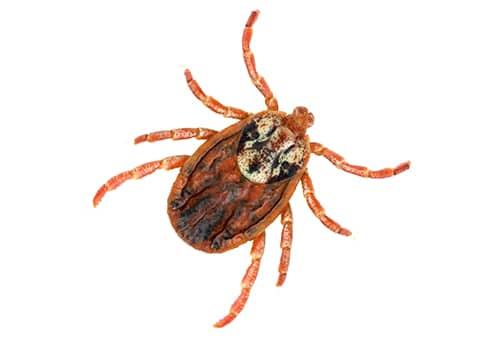
American Dog Tick
The American dog tick is 3/16 of an inch long and brownish colored with white or yellow markings. These markings look like marble and can be found on the top half of a female tick's back and on the entire back of a male tick. This tick gets its name from its preference for the blood of dogs. When a young American dog tick matures and falls off its first host, it is likely to seek a domesticated dog as its next host. This puts dog owners at greater risk for diseases spread by this tick.
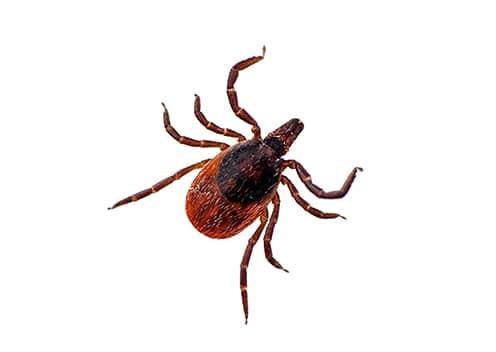
Blacklegged Deer Tick
The blacklegged tick is about ⅛ of an inch long and entirely black or a mixture of black and orange, depending on the sex. Females have an orange coloration on the bottom half of their back in the of a shape of a crescent moon. This tick gets one of its names from its preference for the blood of white-tailed deer, but in its early stage of development, it can be found feeding on mice, squirrels, birds and other small animals which are more likely to bring these ticks into your yard.
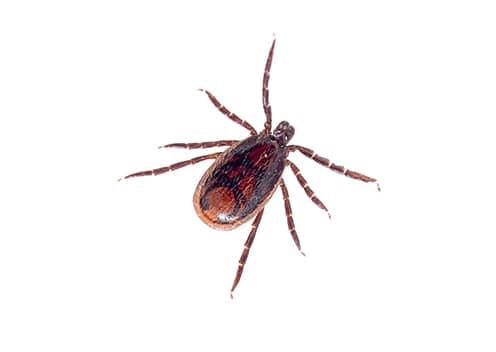
Brown Dog Tick
The brown dog tick is about ⅛ of an inch in length and reddish brown in coloration, with males being a darker color than females. Of all the ticks that get into our homes, this is the only tick that can complete its entire life cycle indoors. This makes it a serious threat, especially to dog owners as they are commonly found on domesticated dogs.
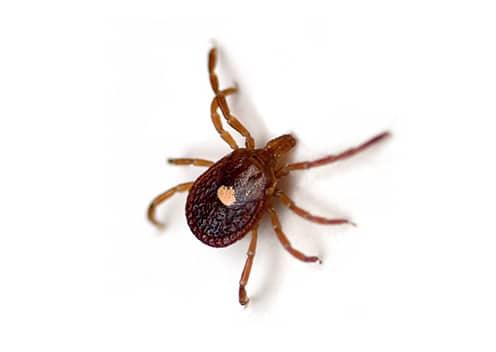
Lone Star Tick
The Lone Star tick is around ⅙ of an inch long and reddish brown in coloration. Females of this species bear the single white or yellowish dot on the back, which inspired its name. This tick does not survive long in the sun and is not usually found outside of shaded hiding places. In all of its stages of development, this tick will attach to humans.
All ticks are not created equal when it comes to the spread of diseases. While there are some diseases that can be spread by all tick species, some species pose more of a threat for some diseases than others.
The deer tick, for instance, is a known vector for Lyme disease, making it a dangerous tick to find in your yard. Lyme disease, which is often associated with a bullseye rash, comes with many unpleasant symptoms.
If not caught and treated, it can progress to a chronic stage which shares symptoms with serious illnesses such as Bell's palsy, fibromyalgia, Alzheimer's diseases, amyotrophic lateral sclerosis (ALS), bipolar disorder, chronic fatigue syndrome, and more.
To make matter worse, there is some controversy among medical professionals about where chronic Lyme diseases exist, which can dramatically affect the treatment options for Lyme disease sufferers.
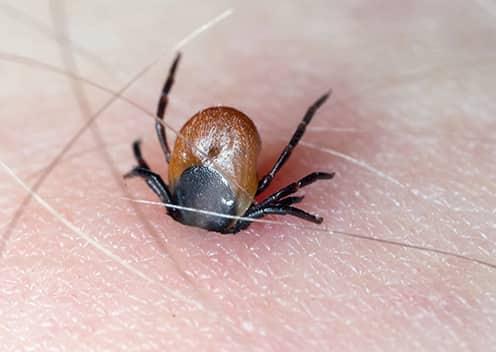
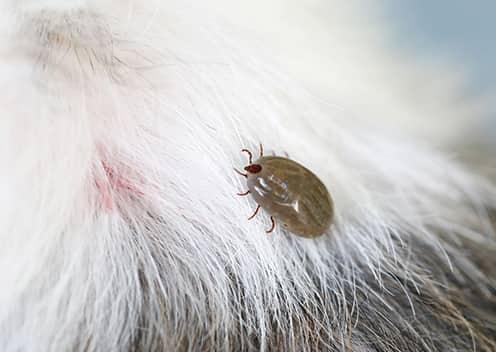
Though it is the most recognizable of tick-borne diseases, Lyme is not the only disease spread by ticks to humans, dogs, and cats. Here are a few you should be aware of:
• Rocky Mountain spotted fever (RMSF): RMSF is a bacterial disease that begins with a fever, headache, and rash. If not treated early with the right antibiotic, it can be deadly. RMSF is known to be spread by several tick species.
• Babesiosis: Common in the Northeast, babesiosis is known to be transmitted by deer ticks. An infection of babesia usually does not come with symptoms but it can lead to hemolytic anemia from the destruction of red blood cells in the body.
• Anaplasmosis: This is a disease primarily caused by a bacterium known as Anaplasma phagocytophilum, which is spread by deer ticks.
A lesser version of this disease is caused by the bacterium Anaplasma platys, which is spread by brown dog ticks. In a dog, it can produce lameness, lethargy, fever, joint pain, and a lack of appetite, in its early stage.
Symptoms usually only last 1 to 7 days. In some cases, symptoms can be much worse, depending on the type of bacterium and other factors. In humans, it can cause flu-like symptoms and, in rare cases, progress to respiratory issues, organ failure, and death.
• Ehrlichiosis: The symptoms of this disease may include fever, chills, lethargy, lack of appetite, swollen lymph nodes, bruising or bleeding, eye inflammation, lameness and neurological abnormalities for dogs and cats.
When contracted by a human, symptoms tend to be fever, chills, headache, muscle aches, nausea, vomiting, diarrhea, loss of appetite, and sometimes confusion. In children, a rash is common. Early treatment can reduce the risk of developing severe illness and prevent death in both humans and pets.
Other diseases to be aware of are tularemia, Southern tick-associated rash illness (STARI), 364D rickettsiosis, rickettsia parkeri rickettsiosis, Powassan disease, Heartland virus and Colorado tick fever. All of these come with their own risks and symptoms.
Do you think you have Lyme or one of these other diseases? Bring evidence to your physician. Capture the tick and take a photo if you see a bullseye rash on your skin. These will prompt your medical care provider to take appropriate action to counter tick-borne diseases.
Your backyard is the frontline in the war on tick-borne diseases. Before ticks get on your pets or on you, they are brought into your yard by wildlife.
There are many animal pests that put you at risk for exposure. The most noteworthy is the common house mouse. A mouse can have as many as a hundred seed ticks on it.
Seed ticks are six-legged tick larvae that develop on a small host and then drop off to find a larger host. They begin with small animals like mice and rats then graduate to cats, dogs, and even humans.
So it is never good to have rodents in your yard, and even worse to have them in your home.
Several animals are considered pest animals. You've probably dealt with a few over the years. Have your trash cans been knocked over by a raccoon?
Has your dog been sprayed by a skunk? Have you had the displeasure of sharing your backyard with a mound-making, plant-eating, groundhog?
All of these animals can bring ticks into your yard. There is, however, one animal pest that is considered to be an exception. It is the opossum. Not only are opossums poor reservoirs for Lyme disease, but they eat ticks and the rodents that carry ticks.
But before you start thinking that opossums can take care of your tick control, you should know that they lack commitment and thoroughness. It is best to leave this important job to human pest control professionals.
Sometimes it can be difficult to figure out what bug bit you. If you have a red, itchy lesion on your skin, it could be a tick bite. But other bugs can cause a bite like that.
The easiest way to tell that you've been bitten by a tick is when you see a bullseye rash on your skin. But a bullseye rash is a sign of a Lyme disease infection.
So this is definitely not the way to find you you've been bitten by a tick. Early detection is best.
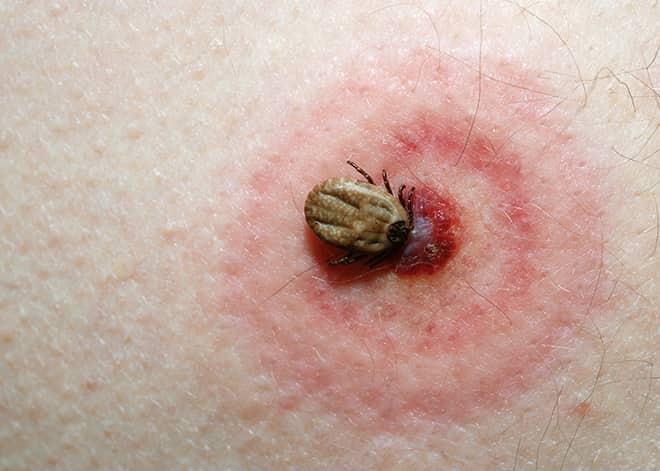
When you come in from being in nature, it is a good practice to do a search for ticks. Feel around on your skin for a bump. Ticks may be found anywhere on your body from your ankles to your neck.
They rarely attach above the neck on adults but are commonly found above the neck on children, according to a German study in which the data from 10,000 tick bites were analyzed.
Ticks can attach for up to 3 days. The longer they stay attached, the more engorged they become. This can help you locate a tick that is feeding on you. And detecting a tick early can prevent the spread of diseases. Lyme disease, for instance, can take as long as 48 hours to transfer from an infected tick.
On dogs and cats, ticks have a preference for where they will attach. They are often found between the toes or in the ears. These are the best places to quickly check your pet for ticks.

When you find a tick on your skin, it is important to remove it properly. Squeezing a tick wrong can allow more disease-causing bacteria to enter the wound.

Use a tick-removal device or some needle-nose tweezers to extract the tick. Do not use dull-tipped tweezers. You need to be precise about where you grab the tick to remove it.
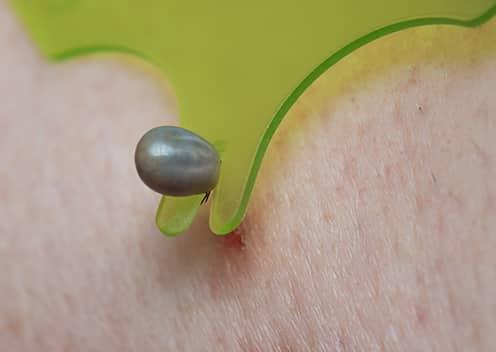
Pinch the tick toward the head and avoid pinching the abdomen.
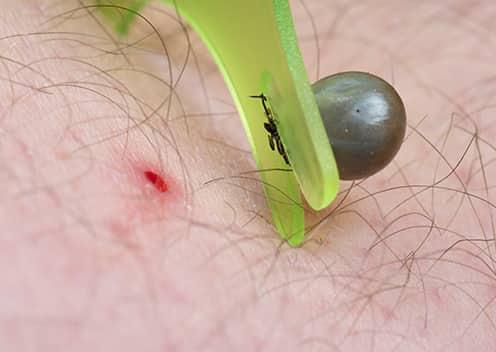
When you pull it out, pull directly away from your skin in a slow, steady movement. Don't twist, jerk or slide. This can cause the mouthparts to break off and stay lodged in the skin.
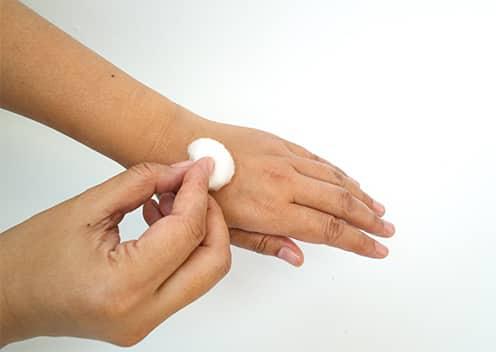
After you've removed the tick, be sure to sanitize the wound with rubbing alcohol or some other disinfectant or antibacterial agent. Take note that using rubbing alcohol to attempt to make a tick disengage does not work. It is only good for sterilizing harmful bacteria on the wound.
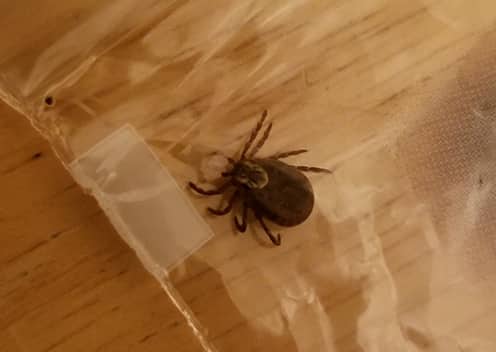
Once the tick has been extracted, dispose of it by putting it outside or flushing it down the toilet.
If you intend to keep it, put it in a sealed bag or container. It is best to not handle it.
Keep in mind that home remedies such as painting a tick with nail polish, covering it with petroleum jelly, or burning it with a hot match will not work for tick removal. And you should never wait for a tick to just fall off. As mentioned, early removal is key to preventing the spread of diseases.
Use the tick-removal tips above for removing ticks from your dog or cat. If you find multiple ticks, especially in the ear, you may want to see your veterinarian.
There are many ways to reduce the risk of getting a tick bite or contracting a tick-borne disease.
You can take personal precautions such as applying bug spray to your legs before going out into areas where ticks may be present, investing in veterinarian-prescribed tick products to protect your pet, and by controlling where your dogs are allowed to play in your yard.
But the best way to guard yourself against ticks and the diseases they carry is to prevent ticks from invading your yard.
To do that, you must take measures to control wildlife. We touched on this above in our "spring tick control" section but, since this is such an important factor for controlling ticks, let's get into more detail.

Though it is the most recognizable of tick-borne diseases, Lyme is not the only disease spread by ticks to humans, dogs, and cats. Here are a few you should be aware of:
• Food sources: Besides trash cans, pet food, and leftovers on the grill, wild animals can be attracted to a wide range of food options.
Some rodents chew on the bark of trees. If you see damage at the bottom of your trees, you should put a skirting around your trees to resist rodents. Some animals are insectivores. If you have lots of bugs in your yard, they'll be happy to come into your yard and bring ticks with them.
A residential pest control program can help to reduce bugs and the animals that eat them. Some animals eat vegetation.
The more plants you have, the more likely you are to have these animals coming and going from your yard. There isn't a lot you can do about this one except, perhaps, installing fencing around vegetation that is being chewed on.
• Watering Holes: Any container in your yard that captures rainwater can become a watering hole for wildlife. Removing containers will not only reduce water for drinking, it will remove a potential location where mosquitoes can breed. It is a win-win.
• Hiding Places: There are many objects animals will use as hiding places or harborage options. It could be an appliance being stored in the backyard until you can bring it to the dump.
It might be an old automobile that is only good for parts. It may be a structure, such as a shed or outbuilding, that a burrowing animal can create a void underneath, or a deck that already has a void underneath.
Removing objects that animals can hide in, and fencing off areas where they can hide, will help reduce ticks in your yard. As animals go in and out of locations of harborage they usually pass through tall grass, bushes, and other vegetation where ticks can drop off and wait for another host.
While the tick control tips we've shared so far can help you prevent ticks from coming into your yard, they are not the way to go if you have a tick-infested yard.
Ticks are dangerous pests that should be quickly addressed when they appear—and tick control is best performed by a licensed and certified professional.
A professional knows the unique biology of ticks and what their habitat preferences are. Your pest professional will take into consideration your unique landscape and the area surrounding your yard in order to put in place a service that will be effective for your individual needs.
This will require a tick spray treatment applied to tick zones around your home and it may also include rodent control.

Tick-reduction treatments work to eliminate ticks in the places they hide. Most ticks can't survive long out in the open.
They hide in vegetation and in shaded locations on your property. Your pest control professional uses this knowledge against them.
A tick treatment is applied under your deck, along your fence line, in wooded areas, on your lawn, and in other locations where ticks hide.
It will work to eliminate ticks that are present in these areas and take down ticks that are introduced into these areas. This will prevent ticks from getting on you, your kids, or your pets.
Pests can be a serious threat to your health and the health of everyone living in your home, and ticks are just one of many dangerous pests we have in our service area.
Mosquitoes spread dangerous viruses. Cockroaches spread bacteria, diseases, parasitic worms, and allergens. Fleas transmit diseases and tapeworm. Rodents spread bacteria and diseases. Wasps pose a threat to anyone who is allergic to their venom.
No home should be without a residential pest control plan.
Rodent control helps to address the vehicles that bring ticks into your yard and potentially into your home.
Mice and rats seek harborage in man-made structures. Once inside, they're happy to live with you permanently, while continuing to come and go as they please.
Each trip outside presents an opportunity for ticks to get on those rodents, and for those rodents to bring ticks into your home.
That's why Rodent control has a dual effect.
Devices placed in your yard work to capture rodents before they get into your yard or as they are leaving your home to go foraging for food outside.
This prevents them from bringing ticks back into your home.
It also prevents them from bringing harmful bacteria and diseases into your home. No residential pest control program should be without a quality rodent control service.
That is why all of the programs we offer at American Pest include exterior rodent protection.

So, what do you do if you see ticks in your home? In light of the threats ticks and other pests can pose, it is vital to find a pest control provider with a strong reputation for excellent service. Here are three easy ways you can know that American Pest is the right choice.
When you choose American Pest for your tick protection, you have options. You can choose one-time tick treatment to protect a special event; invest in seasonal mosquito and tick control for ongoing protection around your home; or put in place a comprehensive residential pest control plan that includes treatments for ticks and mosquitoes.
If you choose a residential pest control plan from American Pest, you get control for rodents. That is no small point. Mice and rats are so linked to tickborne diseases that scientists can predict Lyme disease cases by looking at mice populations in a particular area the year before. Jump over to our tick protection page to learn more about our approach to tick control in Maryland, D.C., and Northern Virginia.
We align with the best, to bring you the best.




If you have questions about our services, plans, or pricing, we are here for you. Call or fill out the form to communicate by email.